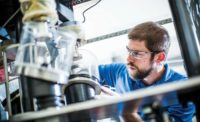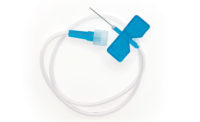Testing New Generation Medical Devices
Medical device and materials innovation demands detailed analysis of the mechanical performance of components.






It is hard to overestimate the importance of quality and reliability in the area of medical devices since the lives and well-being of individuals are at stake and the industry is so tightly regulated. It is, therefore, a well-established area of standards and of scrutiny. Manufacturers and suppliers need to be vigilant, not least because any harm from unforeseen circumstances can lead to litigation against users, suppliers, clinicians and manufacturers.
TECH TIPSIn the course of applying force or torque, many unseen things are also happening. On a production line, constant repeatable sample testing can identify manufacturing quality drift, and feedback information for corrective action before a line goes out of tolerance. The right tests are selected and programmed into force and torque testers at the production line, and they perform the same test reliably every time. |
The global medical devices industry is extensive, predicted to reach an annual $398 billion by 2017, and includes the simplest of mass-produced components to highly specialized one-off items and new materials development. And yet for everyone concerned, a substantial part of quality assurance testing boils down to pushing, pulling and twisting.
Production quality
That might sound simple, but in the course of applying force or torque, many unseen things are also happening. On a production line, constant repeatable sample testing can identify manufacturing quality drift, and feedback information for corrective action before a line goes out of tolerance. The right tests are selected and programmed into force and torque testers at the production line, and they perform the same test reliably every time. What is the right test?
International standards are well-established for all medical devices to ensure they are strong enough, sharp enough, adhere and peel consistently, click, bend or stretch according to specification. It still sounds simple to measure and assess for quality, and at one level it is. With a universal force tester, fixtured to grip the item in question, all you need do is drop in the sample, start the test and remove the sample. An immediate response can be indicated to pass or fail the sample, whilst storing the raw test data for each batch for later analysis and comparison, and to provide a complete audit trail.
For standard components, not a lot changes over time, and the international standard test methods apply (examples are given in parentheses below). Will an infusion tube become disconnected from a coupling within required limits of force or pressure (ISO 80369-1)? Will a single-use needle batch penetrate skin easily every time (BS EN ISO 7864, BS EN 11608), and the sharps bin you put it in be puncture resistant (ASTM F2132, BS7320)? Is the plunger-activation force for a syringe consistent with the requirement for a syringe pump (BS EN ISO 7886-1)? Will a bone screw drive in cleanly and achieve the right torque (ASTM F543, BS 3531-5.6, ISO 6475)?
Thousands of quality assurance checks like these are easily performed in repeatable ways, using universal testers and international standard methods to apply tensile and compressive forces or torque. A great deal of detail can be obtained by using fully programmable testers, so they are used from the design stage through to production lines. Sometimes a single measure is required (for example, a peak force or a break point), but frequently the detailed characteristics of a test to failure, or a test to release, yield more useful information. This may be required as evidence or for analysis, if ever product performance is questioned.
Precision measurement
One of the most ubiquitous and simplest-looking devices is the Luer lock (BS EN 1707, BS EN 20594-1, ISO 594). It is designed for secure leak-proof connections, but quick application and release of syringes to needles (BS EN ISO 11608-2). Billions of these are used each year, but the patient whose vein is traumatized by sub-optimal performance of one may suffer more than a little temporary pain. The real problem is not the one-off substandard item, but the production quality drift that leads to the costly and damaging distributed batch recall.
By plotting test data a thousand times a second, we can see how things deform or fail, and develop better designs. This is especially important for new devices and materials. The pressures on medical devices design and manufacturing include the common ones of materials saving and weight reduction, but safety factors are even more demanding.
A suitable high-precision torque tester, capable of measuring down to just a few mN·m, can detect imperfections in a Luer screw thread that may be traced to the manufacturing process and rectified before it becomes a problem, whilst also being able to test to failure. A Luer fitting may be designed for light application—but that doesn’t mean a strong hand won’t overdo it! Capturing the finest torque characteristics of the point of securing or releasing, whilst under representative push or pull forces, requires a sophisticated torque tester.
Patient drug-delivery
There is still a trend in pharmaceuticals delivery towards patient application, partly for convenience and partly to save specialist appointment time. Single-use devices from prefilled syringes, dose-controlled injectors to inhalation devices and transdermal patches are therefore used, but more variably than in skilled hands.
Dose-delivery is a critical element, and will rely on an assembly of mass-produced parts such as plastic components, buttons, triggers, dials and springs. Each of these will need batch sample testing, because failures (for example a spring being not quite strong enough) may not lead to immediate detection of under or over-dosing. Whilst simple mechanical force testers can measure spring rates quite accurately, programmable motorized testers can massively increase throughput, whilst offering the flexibility of storing a library of compression and tensile test routines for many kinds of springs.
New developments
At the other end of the spectrum are devices of novel design, or custom-made to individual requirement, where testing to failure of prototypes may be important, or the final product strength tested without damaging it. Prosthetic limbs of carbon composites, bionic devices, and replacement joints or implants may seem like many other engineering solutions, but failure and malfunction can cause serious injury. Again, comprehensive, accurate and repeatable testing is essential, though in areas where directly applicable standard test methods are unavailable or need adapting.
Recent examples in the news of additive manufacturing (‘3-D printing’) include maxillofacial prostheses which need strength and lightness, cavities for muscle attachment and channels for nerves. Such complex, radical, permanent and irretrievable devices must be proven in both material and design principle. The joint stress forces are measurable, the mechanical requirements known, and titanium as a material can be compared with bone for density and strength. Additive manufactured metals, however, differ from cast or wrought equivalents. They benefit from being a single integrated part, are typically stronger, but are less ductile and can contain residual stresses. Conventionally-produced prostheses by contrast may require multi-part assembly or reworking, with different points of weakness.
Comparative testing of the same components, manufactured by different processes, can therefore provide essential data for choice of manufacture method for a particular required application, depending on where in the body it is required. A computerized universal tensile and compression tester that can test for flexure, break point, tensile strength and pull-out of fixings, will be able not only to put a component design through its paces, but in the detail of the data, identify points of potential weakness.
Another area of medical devices where testing is essential is in new coatings, adhesives and cements (ASTM F1160, ASTM F2255, F2256, F2258). For external devices, conventional forms must mainly be resilient to their expected environment (temperature, solvents, fluids etc.), but used internally, other factors are involved. The adhesive used for a transdermal patch can easily be user tested as well as in standardized conditions, because reapplication is easy, and inactive samples can be used. Similarly, a novel wound-closing adhesive (ASTM F2458), as a substitute to sutures or staples, can be used externally in vivo where alternative tested solutions can be quickly used in case of failure.
The problem is that extensive testing for internal use during surgery, such as in heart valve repairs, can’t allow for failure. Rigorous tensile testing on wet cultured or synthetic skin can be performed in highly controlled and monitored conditions. A universal tester can programmatically and cyclically test shear, tensile and peel strength characteristics with different formulations under the same conditions. The repeatability of both the test method and conditions provide reliable data in a way that in vivo testing cannot.
Summary
Fully programmable force and torque testers take the variability out of quality testing medical devices and components. Using a library of international standard and custom test methods, they perform a wide range of tests, from the production line to the specialist design laboratory. Medical device and materials innovation demands detailed analysis of the mechanical performance of components, since their application is so critical and highly regulated for safety.
FOOTNOTE
Visiongain (2013), Medical Devices Industry and Market Prospects 2013-2023
Looking for a reprint of this article?
From high-res PDFs to custom plaques, order your copy today!








